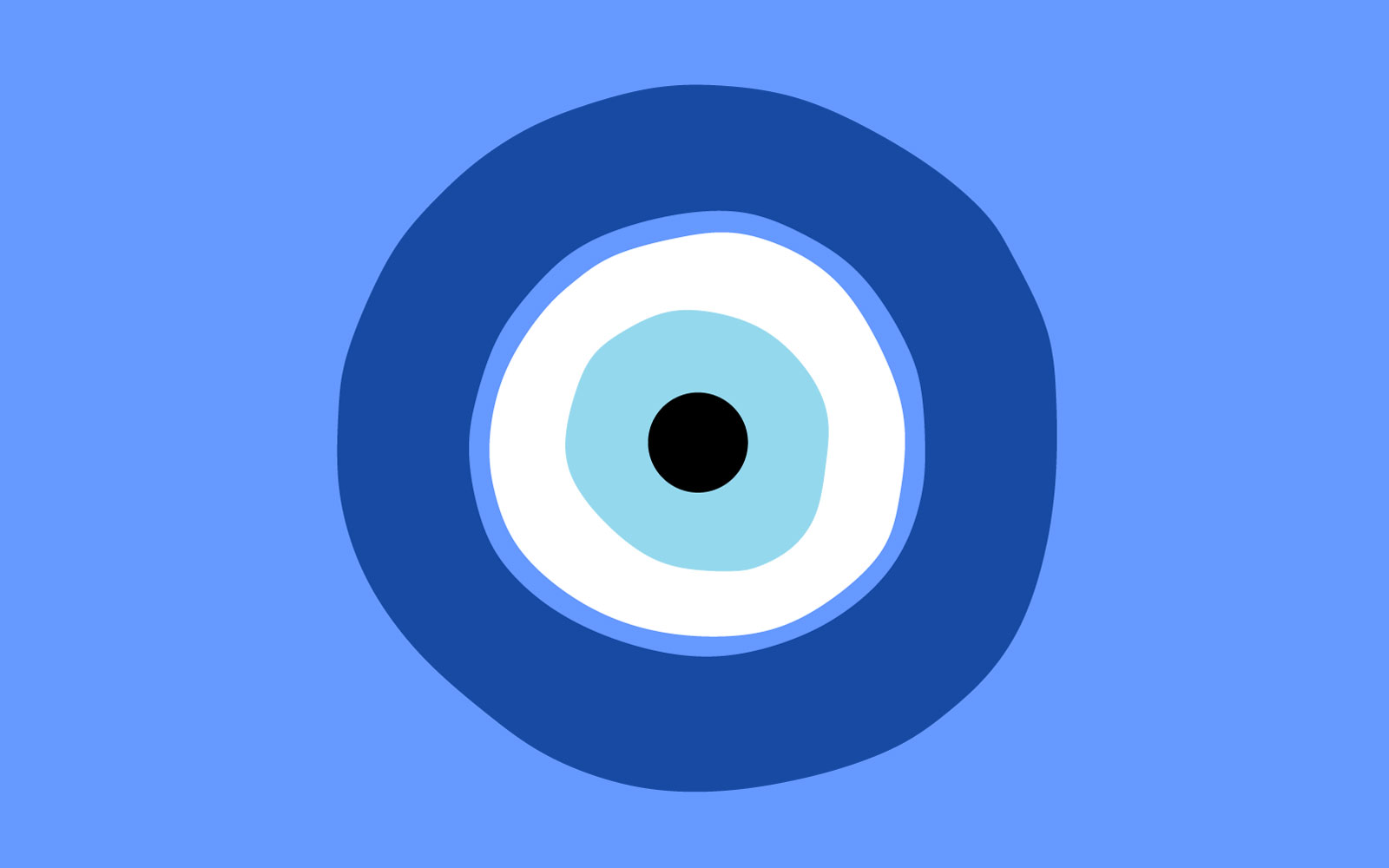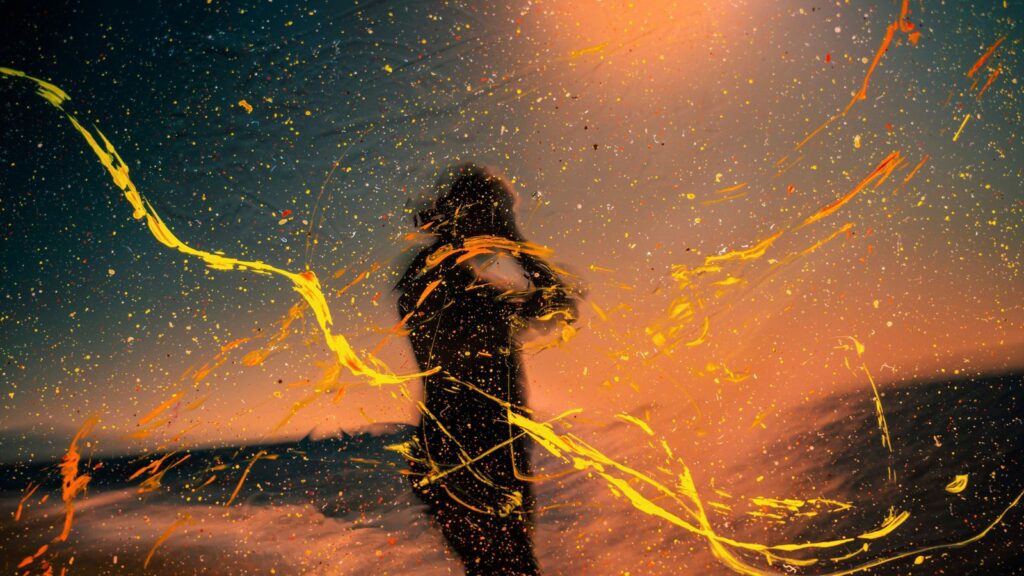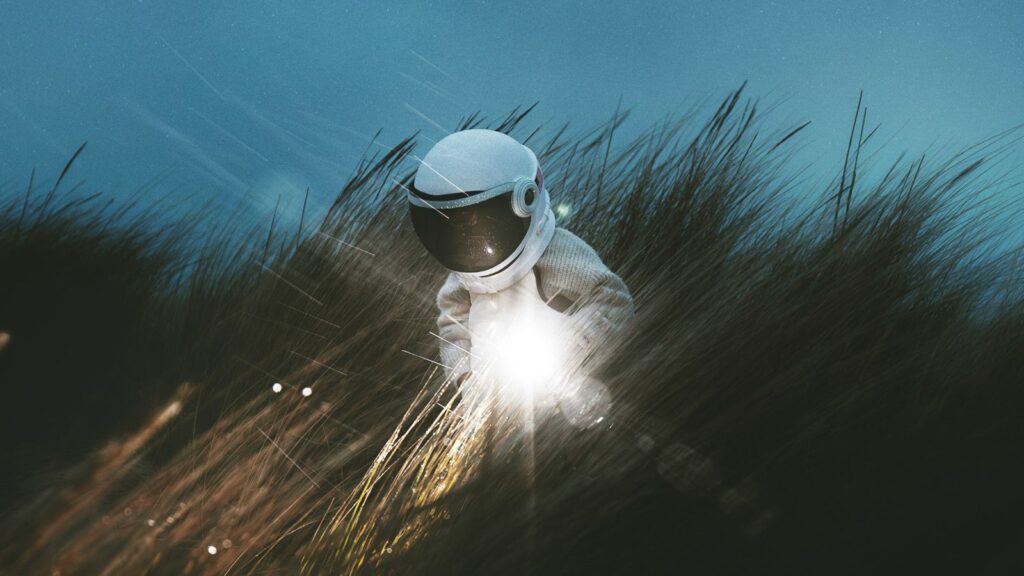Aaron Moulton is a curator that works with contemporary art, artists, and art worlds by building different frameworks of context in order to analyze cultural phenomena. His latest exhibition, Pineal Eye Infection, maps realities that have been traumatized by psychedelics, perception, and madness. “While an art exhibition doesn’t seem like a place for healing, it is, in fact, a portal and place for energy alignment. Imagine it like an altar or superstitious ritual,” Moulton says.
Moulton brings together a variety of different divination disciplines and perspectives in a multi-media, multi-dimensional experience that even includes scent. He worked with a perfumer to create the scent of DMT, which pumps throughout the space during the exhibition. The introduction to the exhibition is a mock pharmaceutical commercial featuring Moulton as a doctor selling the idea of a transcendental experience.
“Propaganda gets a bad rep,” Molton told us.
We sat down with Aaron Moulton to discuss the Pineal Eye Infection exhibition, art as a vehicle for spirituality, psychedelics, and propaganda.
Meet Aaron at Meet Delic
Aaron Moulton is one of the amazing speakers that will hit the stage for Meet Delic–the first-ever psychedelic wellness summit of its kind. We’re bringing the leading minds in psychedelic science and wellness to the Wisdome LA immersive art park. Don’t miss it!
RS + Aaron Moulton Interview
Reality Sandwich: You’re doing some a presentation on the pineal gland and it’s a relationship to creativity in artists at Meet Delic, correct?
Aaron Moulton: I’ve just put together a large exhibition here in L.A. It’s essentially repackaging the creative impulse as a form of energy work and looking differently at artists as not just the creative or cultural producers but as shaman embedded among us in society. The way I’ve tried to repackage it is through the language of illness, looking at how the pineal gland could be creating an uncontrolled or involuntary desire for visionary experience within the individual and in particular with the artist. Let’s call them real artists, or a version of an artist who doesn’t have a choice, who wakes up in the morning and they don’t do this for the industry or for the likes but they have uncontrollable energy that they have to express from their mind, through their body, and into something material.
That’s kind of the gist of it. There is a roster of different, what’s called an “ambassador’s energy system” who are giving us different ways of imagining portals, energy work, energy objects. All of this is packaged within the context of contemporary art.
RS: When you say ambassadors, you’re talking about real people?
AM: Yes. I set up a spectrum that’s very anthropological. There are different camps of energy work, from the occult, pseudoscience, Christianity, shamanism, or what have you. Each of these camps has what we can call ambassadors that are representing their energy system.
RS: How does the audience engage with these different energy systems?
AM: Typically, you’re given a press release when you come into an art exhibition. I look at that as an obsolete technology, because people don’t take the time to read it anymore and if they do, it’s cursory. I work a lot with filmmakers here in Hollywood to reimagine this part of the experience by looking at the propaganda within our culture and environment that we digest all the time, pharmaceutical commercials being king among them. So, I’ve written a script, let’s call it the press release, that I deliver as if it were a pharmaceutical commercial.
I’m selling this idea through the voice of a doctor. I look at it as aspirational propaganda. Propaganda gets a bad rap even though we’re constantly consuming it through marketing and so forth. I’m just trying to reclaim these preexisting structures that are constantly taking advantage of us and to disseminate a message through that framework.
RS: What is that message?
AM: Repackaging creativity and creative impulse. Divination is something I quite seriously believe in. I’m also experimenting with the believability of those practices. In its most generic explanation, divination is the ability to detect energy vibrations within or without. Any kind of vibration, and there’s hundreds and hundreds of them. I look at this idea of the involuntary artist, a person who is a medium for energy, as a medium for divination. The pharmaceutical commercial is about divination and the creative impulse.
RS: I have so many questions. just kind of wanting to penetrate stuff. Since you’re coming and speaking at a psychedelic conference, what’s the correlation between psychedelics and creativity?
AM: In the camps, I’m looking at realities that have been traumatized by psychedelics, perception, and madness. I also have been sensitive to psychedelia and psychedelics. I have artists such as Alex Grey that don’t appear in the mainstream contemporary art world because they’re not taken seriously, or they’re just outside the canon for whatever those reasons are. In addition to that, I’ve worked with a perfume company, and they’ve produced the smell of DMT to perfection. We have that pumping into the space. It’s in the pineal gland. DMT has this complex relationship to a very traumatic psychedelic experience that’s also very blissful and whatever else you want to attach to it.
RS: Even by how you’re describing the scent, and what I’m gathering is that there seems to be a relationship between trauma and transcendent experience. Am I reading this correctly?
Aaron Moulton: They’re kind of the same right?
RS: Can you extrapolate on that?
AM: A transcendental experience in a true sense of losing the ego (ego death) is going to be also a trauma. It’s something that will very much scar that person in a positive way. Traumas have a spectrum that we typically associate with being negative. They are things that fundamentally alter perception, and any kind of form of trauma is going to help guide your perception.
RS: How did you become interested in this subject?
AM: I work as a curator in the contemporary art world but I see my role as more of an anthropologist. I’ve kind of hacked my industry to perform art and anthropological experiments. This industry is littered with things that no one can really identify as art or not. It’s a funny gift as much as it is a weakness. Nobody truly knows what is art. I saw that as a real gift in terms of identifying magical practice and other kinds of energy-based phenomena. However, I look at all cultural phenomena through the prism of context. There are ways to look at this art thing through different prisms; spiritual, occult-based, pseudoscientific prism. My work as an anthropologist, curator person is to find prisms to help frame this thing that we all accept universally, yet no one truly knows exactly what it is.
RS: An artwork has an energetic resonance. It’s something you can feel, and it’s not just art. It’s objects, anything really, even if inanimate. In the context of this, I’m starting to see the sort of lenses through which you’re looking at art, as access points. What sort of responses have you been getting from people?
AM: You don’t have a show like this happening anywhere in the world. I’m working with all these major occult figures like Ingo Swann, who’s the most important clairvoyant of the 20th century that gave us the idea of remote viewing, to shamanic types to Thomas Kinkade, the voice of the Christian right and painter of God’s light.
RS: What has this taught you about the creative process?
AM: Every time I create a prism, let’s call it, I transform myself as a mediator to help create empathy for that prism or that context. In this case, this is rooted in pseudoscience and trying to impose a rational language on fundamentally irrational things. Art is a pseudoscience. It’s not just having it in a cold museum environment but actually having events to help activate the space and make it an energy laboratory.
RS: I wouldn’t necessarily say that the art world and divination worlds are separate in regards to creativity and form, but classically speaking, they haven’t been in the same space.
AM: It’s reframing the creative impulse as a form of energy. I’m in an industry [art world] whose main purpose or goal for that energy work is decorative. There’s a couple of things happening here that are revolutionary. I’m asking things to have utility, a certain degree of intention that go beyond self-referential. Art never asked to be useful. That’s the last question anyone asked of an artwork: “what is it good for?” I truly believe in holistic value. This kind of work is actively engaged in pursuing it, whereas the grandest goal that most art is given in my industry is a decorative subservient to marketing.
RS: I’m curious to hear your thoughts about how we frame the mental illness discussion in this culture. Do you agree with that terminology?
AM: I’m not saying anything new, but the United States is not well-educated about how to deal with mental health. In fact, it’s done everything to deny the need for that kind of education. When I discovered meditation, I was like, “This was free and available all this time?” You’re told to work on your physical hygiene, and if that doesn’t work out you have drugs, alcohol, pharmaceuticals, and a shrink. You’re never given the tools to deal with mental hygiene in this culture if it doesn’t attach itself easily to marketing.
That’s a strange thing in capitalism. Of course, with what Meet Delic is doing, and what’s just happening in terms of our evolutionary process right now as a species, we’re going to come to better terms with some real tools that are going to radically shift our perception and our needs.
RS: The transcendent experience as an example of positive trauma is interesting.
AM: We have lots of them right? We’re littered with all kinds of traumas in our daily experience. Death and birth are seen as traumas with a capital T, which gives it a kind of negative resonance. My wife giving birth to our two kids was a transcendental trauma. I went outside my ego, got a completely new perception of life.
RS: I was talking to a Shaman once about mental health. He was saying that there are people that approach reality from a different angle. Our culture isn’t really built to kind of deal with that, accept, or even understand it. There are so many ways of approaching reality. Your project seems to be happening on different levels. You’re setting up lenses through which you approach reality.
AM: I don’t think that people go to exhibitions that much anymore. Making this propaganda film is paramount for me because it, at least, creates an intense feeling versus giving people a piece of text and hoping they read it. A lot of people have seen this film and are like, “Fuck, okay.”
RS: Because it’s propaganda?
AM: It’s aspirational propaganda. The only thing negative about my message is that it fucks up your safe space about art completely.
RS: What’s your safe space?
AM: It comes back to this idea of the artist who has a choice. There is a huge industry, from the educational complex to the art world, where there is a lot of stuff that is produced to satisfy industry standards. It’s not doing much for culture. What I’m saying sounds cynical, but I’ve been in this a long enough period of time to question utility–what is the stuff doing? In a way, I’m looking at art as a vehicle for spirituality. I’m back to the core function of art as it was done by a shaman in a cave to da Vinci to Michelangelo and the Sistine Chapel. There’s a direct line of communication there that’s rooted in propaganda but it’s propaganda for the transcendental experience.
RS: When we talk about psychedelics, what’s amazing is that they are bringing many of these ideas back into mainstream thought. For example, the idea that mystical experiences have therapeutic value. It’s huge.
AM: It’s crazy. 10 years ago, you were unique if you tried ayahuasca. Today, you’re part of a culture essentially.
RS: It’s interesting where your tie-in comes in here about how you are using the propaganda to present and frame it.
Aaron Moulton: This is interesting when it comes to psychedelics. As much as these are of the earth, of the plants, of the people, who owns transcendence?















